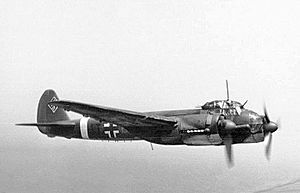Air raid on Bari facts for kids
Quick facts for kids Air raid on Bari |
|||||||
|---|---|---|---|---|---|---|---|
| Part of the Italian Campaign of World War II | |||||||
 Junkers Ju 88, the aircraft type employed in the raid. |
|||||||
|
|||||||
| Belligerents | |||||||
| Commanders and leaders | |||||||
| Albert Kesselring Wolfram von Richthofen |
Harold Alexander Arthur Coningham |
||||||
| Strength | |||||||
| 105 Junkers Ju 88 A-4 bombers | |||||||
| Casualties and losses | |||||||
| One aircraft destroyed | 28 ships sunk harbor extensively damaged 1,000 military and merchant marine personnel killed 1,000 civilians killed |
||||||
The air raid on Bari was a surprise attack by German planes on Allied ships and forces in Bari, Italy. It happened on December 2, 1943, during World War II. German bombers sank many ships in Bari harbour. This attack caused a lot of damage and was even called the "Little Pearl Harbor". A secret cargo of mustard gas on one of the ships made the disaster much worse.
Contents
Why Bari Was Important
In 1943, the port of Bari in southern Italy was very important for the Allied forces. It was a key place to unload supplies like ammunition and food from ships. These supplies were then sent to Allied soldiers fighting in the Italian campaign.
Lack of Defenses
Bari did not have strong air defenses. There were no RAF fighter planes based there. The Allies thought the Germans could not launch a big attack. They believed the German air force (the Luftwaffe) in Italy was too weak. However, German planes had already bombed the port of Naples four times in the month before.
On December 2, many ships from different countries were in Bari Harbour. These included ships from America, Britain, Poland, Norway, and the Netherlands. The port was even lit up at night to help unload supplies quickly.
The Surprise Attack
On the afternoon of December 2, a German pilot flew over Bari. His report led German commander Albert Kesselring to order an air raid. The Germans hoped that destroying the port would slow down the British Eighth Army. They had 105 Ju 88 bombers ready for the attack.
How the Raid Happened
The attack began at 7:25 PM. Two or three German planes flew high above the harbour. They dropped thin strips of foil called Düppel to confuse Allied radar. The German bombers completely surprised the Allies.
They bombed the harbour and the ships. Many bombs hit their targets. Two ships carrying ammunition were hit. A fuel pipeline was also cut, causing a large fire that spread to many other ships.
Damage to the Port
The attack lasted only one hour. Twenty-eight merchant ships were sunk or destroyed. These ships carried over 34,000 tons of cargo. Twelve more ships were damaged. The port was so badly damaged that it was closed for three weeks. It did not fully reopen until February 1944.
The Secret Mustard Gas Ship
One of the ships destroyed was the American Liberty ship called the John Harvey. This ship was carrying a secret cargo of 2,000 M47A1 mustard gas bombs. Each bomb held about 60 to 70 pounds (27 to 32 kg) of this dangerous chemical. The mustard gas had been sent to Europe in case Germany decided to use chemical weapons in Italy.
When the John Harvey was destroyed, the liquid mustard gas spilled into the water. Many sailors who jumped into the water to escape the fires became covered in the chemical.
Effects of the Gas
Within a day, 628 military patients and medical staff showed signs of mustard gas poisoning. They suffered from blindness and severe chemical burns. Hundreds of Italian civilians also sought treatment after being poisoned by the gas. By the end of the month, 83 of the hospitalized military victims had died.
The Cover-up
The Allies tried to keep the disaster a secret. They did not want the public to know about the mustard gas. However, there were too many witnesses for the secret to be kept. In February 1944, the U.S. government finally admitted to the accident. They stated that they had no plans to use chemical weapons unless Germany used them first.
Images for kids


